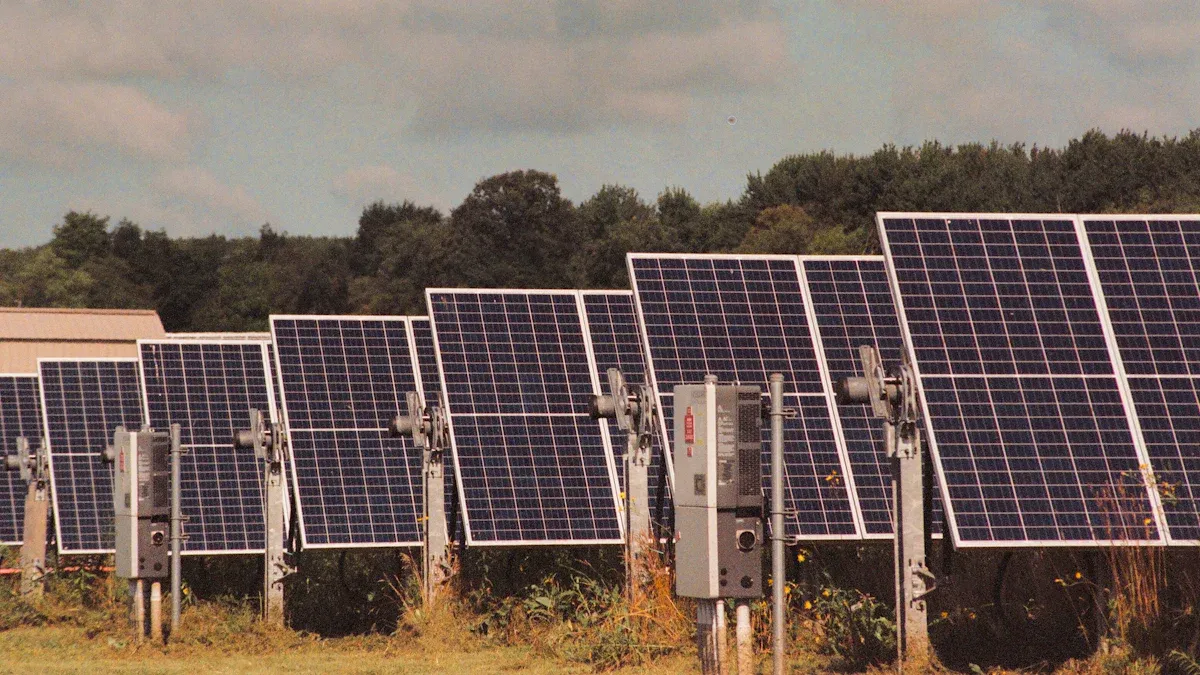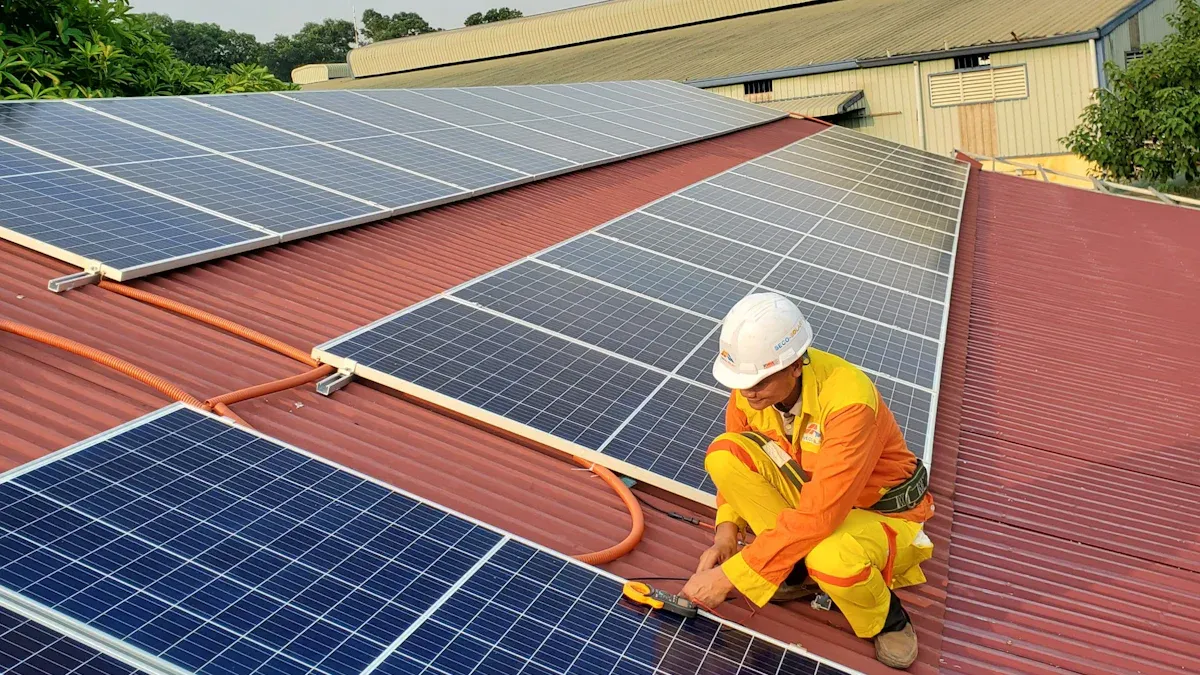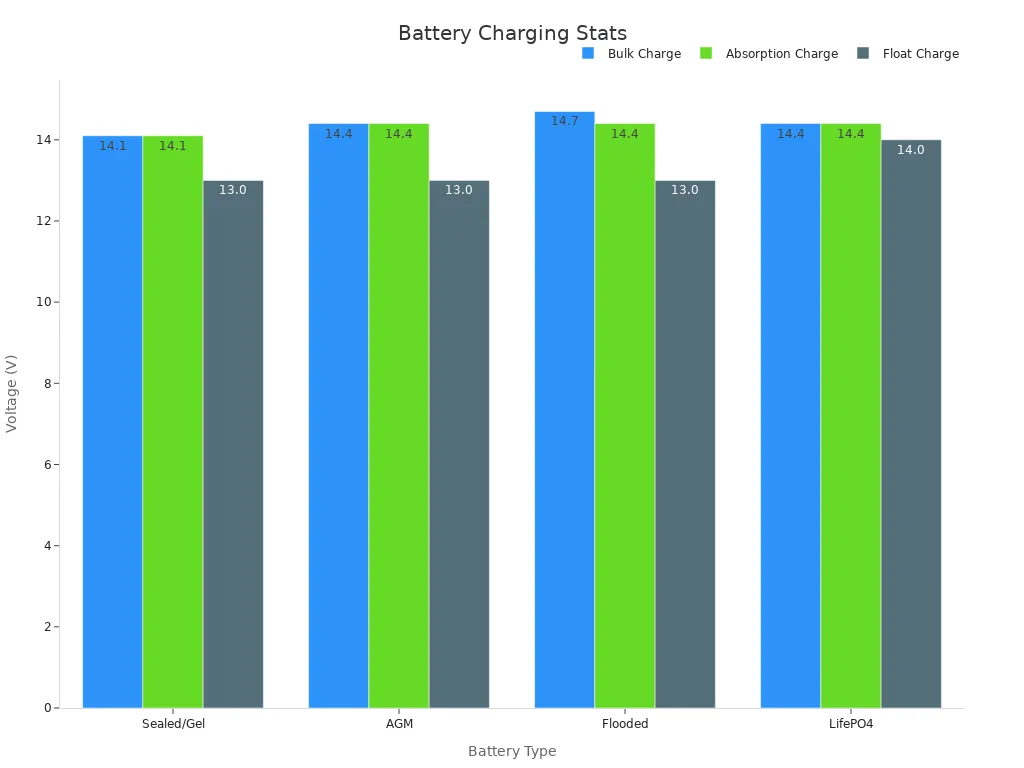How to Select the Best ESTEL PV Solar Charge Controller for Your Needs

Choosing the best PV Solar Charge Controller is very important. These devices manage energy and keep batteries safe from damage. They stop overcharging, undercharging, and harmful changes in power. PV Solar Charge Controllers are becoming more popular, growing 15.5% each year. They help systems work better and make batteries last longer. Good energy begins with them.
Key Takeaways
Pick the right solar charge controller for your system size. PWM controllers work well for small systems. MPPT controllers are better for big systems because they are more efficient.
Check if the controller works with your battery type. Batteries like lead-acid and lithium-ion need special controllers to work their best.
Plan your budget carefully. PWM controllers cost less but are less efficient. Spending more on an MPPT controller can save money later by using energy better.
What is a Solar Charge Controller?
Purpose and Function
A solar charge controller works like a traffic officer. It controls energy flow between solar panels and batteries. This keeps everything working properly. Without it, batteries might overcharge or drain too much. This can damage them or make them wear out faster.
Here’s a simple look at what it does:
Function/Benefit | Description |
|---|---|
Power Management | Makes sure the battery gets enough power without going over safe limits. |
Current Prevention | Stops power from going back to the panels when they’re not working. |
Connection Role | Links panels and batteries for safe power transfer. |
Monitoring | Watches battery voltage to avoid overcharging and helps batteries last longer. |
By doing these jobs, a solar charge controller keeps your system running well and protects your batteries.
Importance in Solar Systems
You might ask, "Why is this device so important?" It’s the heart of any solar setup. It keeps batteries safe and helps the system work better.
Here’s why solar charge controllers are needed:
They stop batteries from overcharging or draining too much, which can hurt them.
They help off-grid systems work better, especially in faraway places.
In areas with little maintenance, they help keep systems running smoothly.
Without a solar charge controller, your system could have big problems. Batteries might not last long, and energy could be wasted. This small device makes a big difference in how your solar setup works.
Types of PV Solar Charge Controllers

When managing energy in your solar system, there are two main types of controllers: Pulse Width Modulation (PWM) and Maximum Power Point Tracking (MPPT). Each type has its own benefits and works best in different setups. Let’s explore what makes them special so you can pick the right one.
Pulse Width Modulation (PWM)
PWM controllers are simpler and easier to use. They slowly lower the current sent to the battery as it gets close to full charge. This stops overcharging but can waste some energy. These controllers work best for small systems where the solar panel voltage matches the battery voltage.
Here’s a quick overview of a typical PWM controller:
Specification | Value |
|---|---|
Nominal System Voltage | 12V |
Max Solar Array Current | 30A |
Battery Voltage Range | 6V – 15.5V |
Max. Solar Panel Input Voltage | 25V |
Temp. Compensation | -24mV/ºF / cell*K |
Operating Temperature | –13 to 122ºF / –20 to 50ºC |
Humidity | 100% N.C. |
Dimensions (H x W x D) | 6.10 x 4.92 x 1.50 in; 155 x 125 x 38 mm |
Weight | 5.34 oz; 151 grams |
Maximum Wire Gauge | #6 AWG |
Warranty | 2 years |
Protection | Battery Reverse Polarity, Over Current |
Tip: For small off-grid systems, PWM controllers are a good choice. Just make sure your solar panel voltage matches your battery voltage for the best results.
PWM controllers are cheap and dependable but not very efficient. They usually work at 75% to 80% efficiency, meaning some solar energy is wasted. However, they’re a great option for smaller or budget-friendly systems.
Maximum Power Point Tracking (MPPT)
MPPT controllers are more advanced and use smart technology to get the most energy from your solar panels. They are perfect for larger systems or when efficiency is very important.
Here’s why MPPT controllers are better:
They can reach up to 98% efficiency, much higher than PWM.
They work well with panels connected in series, allowing higher voltages.
They perform great in cold or cloudy weather when panel voltage changes.
MPPT controllers are ideal for systems where panel and battery voltages don’t match. For example, if you have a 24V solar panel and a 12V battery, an MPPT controller adjusts the voltage while keeping the current strong. This makes them popular for homes and businesses.
Here’s a comparison of efficiency between controller types:
Charge Controller Model | Average Measured Efficiency (%) | Average Predicted Efficiency (%) | % Difference |
|---|---|---|---|
FlexMax (off-grid) | 95.98 | 95.82 | 0.16 |
Microcare (hybrid) | 95.21 | 94.91 | 0.30 |
Microcare (grid-assisted) | 98.21 | 98.16 | 0.05 |

Did you know? MPPT controllers are great for cold places. Solar panels make more voltage in low temperatures, and MPPT controllers turn that extra voltage into usable energy.
If you want the best efficiency and flexibility, MPPT controllers are the top choice. They cost more upfront but save money by making the most of your solar energy.
How to Choose the Right Solar Charge Controller
Picking the right solar charge controller is important for your system. You need to think about a few things to make sure it works well. Let’s go step by step to help you decide.
System Size and Solar Panel Output
The size of your solar system matters when choosing a controller. Bigger systems make more energy, so the controller must handle higher power levels. For small setups, a PWM controller might work fine. But for bigger systems, an MPPT controller is better because it handles more power and works more efficiently.
Here’s how system size and solar panel output affect your choice:
Evidence | Explanation |
|---|---|
Large battery systems need at least a 5% charge rate | Bigger systems need controllers that can handle higher charging needs. |
MPPT controllers work better with higher input voltages | Big systems often make more voltage, so MPPT controllers are ideal. |
Tip: If you have a large battery bank, check that the controller meets the minimum charge rate. This helps your batteries charge well and last longer.
Battery Type Compatibility
Different batteries need different controllers. Some controllers work better with certain battery types. It’s important to check if the controller matches your battery.
Here’s a look at common battery types and their features:
Battery Type | Characteristics | Compatibility with Solar Charge Controllers |
|---|---|---|
Lead-Acid | Cheap, reliable, shorter lifespan, lower energy density | Commonly used but less efficient |
Lithium-Ion | High energy density, long lifespan, fast charging | Works well with advanced controllers |
For example, Lithium-Ion batteries charge faster, so you’ll need a controller that supports this. Lead-Acid batteries are easier to use but may need temperature controls to avoid damage.
Note: Always follow the battery maker’s advice. This helps your controller and battery work together properly.
Budget Considerations
Your budget is another thing to think about. PWM controllers cost less but are less efficient. MPPT controllers cost more but save energy and money over time. Here’s a quick cost comparison:
Controller Type | Efficiency | Price Range (INR) |
|---|---|---|
PWM | 65% – 80% | 1,125 - 3,000 |
MPPT | 15% – 30% more efficient than PWM | 5,250 - 45,000 |
If money is tight, start with a PWM controller. But if you can spend more, an MPPT controller will save you money later by using energy better.
Pro Tip: Think about future upgrades. Spending more now on an MPPT controller could save you from buying a new one later.
Environmental Conditions
Where your solar system is located also matters. Sunlight, temperature, and weather affect how your controller works. In places with low sunlight or cold weather, an MPPT controller is better because it adjusts to changes and gets more energy.
Extreme temperatures can also affect your controller. If you live in a very hot or cold area, pick a controller that works in those conditions. Humidity, rain, and wind can also impact your system, so choose a controller with strong protection.
Did you know? Solar panels make more voltage in cold weather. An MPPT controller turns this extra voltage into energy, making it great for cold places.
By thinking about system size, battery type, budget, and environment, you can find the best solar charge controller for your needs.
Guide to Sizing Your PV Solar Charge Controller

Choosing the right size for your solar charge controller is very important. It helps your system work well and stay safe. This guide will show you how to figure out the voltage and current needs so your controller fits your system perfectly.
Figuring Out Voltage Needs
Voltage sizing makes sure your controller can handle your solar panel's voltage. First, check the open-circuit voltage (Voc) of your panels. This is the highest voltage they can make in perfect conditions. For example, if your panel's Voc is 22.1V, your controller must support at least 22.1V.
If you’re using an MPPT controller, the math is a bit more detailed. MPPT controllers adjust voltage to get the most energy. Here’s an example:
If your panel voltage drops from 30V to 14V, divide 30 by 14. The ratio is 2.14.
If the panel makes 9A, multiply 9A by 2.14. The current becomes 19.28A.
Add 25% for safety: 19.28A x 1.25 = 24.1A. Pick an MPPT controller rated above 24.1A.
For PWM controllers, it’s simpler. Use the short-circuit current (Isc) and add a safety margin. For example, if Isc is 8.68A, multiply it by 1.25. This gives 10.85A. Choose a PWM controller rated higher than this.
Tip: Always include a safety margin for changes in temperature or other conditions.
Figuring Out Current Needs
Current sizing makes sure your controller can handle the amps your panels produce. Start by finding the total current output of your panels. For example, if your system makes 40A, your controller must handle more than 40A.
Here’s how to calculate:
Multiply the current by 1.25 to allow for surges.
If your system voltage is 12V and the current is 14A, multiply 14A by 1.25. The minimum controller rating is 17.5A.
Here’s a quick table for current sizing:
Method | What It Does |
|---|---|
Safety Factor | Adds 25% to handle extra current during surges. |
Current Calculation | Uses total panel current to find the right controller size. |
Power Calculation | Matches panel power to the controller’s voltage and current capacity. |
Pro Tip: Always check your panel details and weather conditions before choosing your controller size.
By using this guide, you’ll pick the right size controller for your solar system. This keeps your system working well and safely.
Features to Look For in a Solar Charge Controller
LCD Displays and Remote Monitoring
A solar charge controller with an LCD screen is very helpful. It shows important details like battery voltage and charging levels. Some also use colored lights to show if the system is working well. This makes it easy to notice problems quickly.
Remote monitoring makes things even easier. You can check your solar system using your phone or computer. Imagine seeing your battery status without getting up! Some systems even use smart technology to give real-time updates. This helps you improve how your system works. If your solar setup is far away, this feature is super useful.
Safety Protections
Safety is key when using solar energy. A good controller has features to protect your system. Overload protection stops the system if too much power is used. Reverse polarity protection prevents damage from wrong wiring. Short circuit protection shuts off power if there’s a problem, keeping things safe.
Temperature compensation is another great feature. It changes the charging voltage based on the weather. This keeps your batteries in good shape. These safety tools protect your equipment and make you feel secure.
Safety Feature | What It Does |
|---|---|
Overload protection | Stops power flow if too much current is used. |
Reverse polarity protection | Protects against damage from wrong wiring connections. |
Short circuit protection | Cuts power immediately if a fault is found. |
Temperature compensation | Adjusts charging voltage based on the surrounding temperature. |
Connectivity Options
Modern controllers have cool ways to connect. Many support Bluetooth, Wi-Fi, or cellular links. This lets you check your system from your phone or tablet. You can see battery levels, solar output, and energy use anytime. This is great for systems in remote areas.
Some controllers even work with smart home systems. You can set charging times or adjust settings to save energy. These features give you full control over your solar system. They also help it run more efficiently.
Tip: Choose controllers with IoT features for the best control and monitoring options.
Recommended ESTEL PV Solar Charge Controller Models
Best for Small Systems
For small solar setups, you need a simple controller. ESTEL makes compact models perfect for small systems. These controllers manage energy from a few panels and protect batteries. They are easy to set up and need little maintenance. Beginners or small-scale users will find them ideal.
These models are budget-friendly and reliable. They include basic safety features like overload and reverse polarity protection. If you’re powering a small RV or cabin, these controllers work well.
Tip: Pick a model with an LCD screen. It helps you check battery levels and solar output easily.
Best for Large Systems
Big solar systems need controllers that handle more energy. ESTEL’s advanced models are great for large setups. Their modular designs let you add storage as needed. This makes them flexible for growing energy needs.
These controllers stay cool under heavy use. They work well for homes or businesses with high energy demands. They also adapt to different solar panels and batteries.
Modular designs allow easy system expansion.
Thermal management keeps performance steady.
Works well with renewable energy systems for flexibility.
Did you know? ESTEL’s large-system controllers perform well in extreme weather. They’re great for different environments.
Best for Off-Grid Setups
Off-grid systems need strong and reliable controllers. ESTEL’s off-grid models are made for remote areas with little maintenance. They maximize energy from panels and keep batteries charged in tough conditions.
These controllers adjust charging based on temperature changes. This is helpful for places with varying weather. They also offer remote monitoring, so you can check your system from anywhere.
Pro Tip: Choose a model with IoT features. It makes managing off-grid systems much easier.
Picking the best solar charge controller means focusing on four things. These are system size, battery type, budget, and the environment. Here's a simple table to help you decide:
Factor | What It Means |
|---|---|
System Size | Your panel and battery size decides the controller's power rating. |
Battery Type | Lead-acid and lithium batteries need different charging setups. |
Budget | How much you can spend affects the controller's features. |
Environmental Conditions | Weather and temperature change how energy is made and stored. |
Think about these points and look for features like safety tools and remote control. This will help you pick the right ESTEL controller for your system.
FAQ
What happens if I pick the wrong solar charge controller?
Choosing the wrong controller can harm your battery. It might shorten its life or waste energy. This is especially bad for off-grid systems.
How can I check if my controller works with my battery?
Look at your battery type and voltage. Controllers usually list supported batteries like lead-acid or lithium-ion. Match these details to avoid problems.
Is an MPPT controller okay for small off-grid setups?
Yes, it works well. MPPT controllers are great for small systems. They give better efficiency and handle changing weather easily.
See Also
Tips for Choosing the Ideal Outdoor Electrical Cabinet
Selecting the Most Effective Cooling Solution for ESTEL Cabinets
Energy Storage Solutions for ESTEL Smart Microgrid Telecom Cabinets
Guidelines for Selecting the Right Outdoor Telecom Cabinet Mount
Telecom Cabinets: Integrating Grid-Connected Inverter and Battery Systems
CALL US DIRECTLY
86-13752765943
3A-8, SHUIWAN 1979 SQUARE (PHASE II), NO.111, TAIZI ROAD,SHUIWAN COMMUNITY, ZHAOSHANG STREET, NANSHAN DISTRICT, SHENZHEN, GUANGDONG, CHINA

